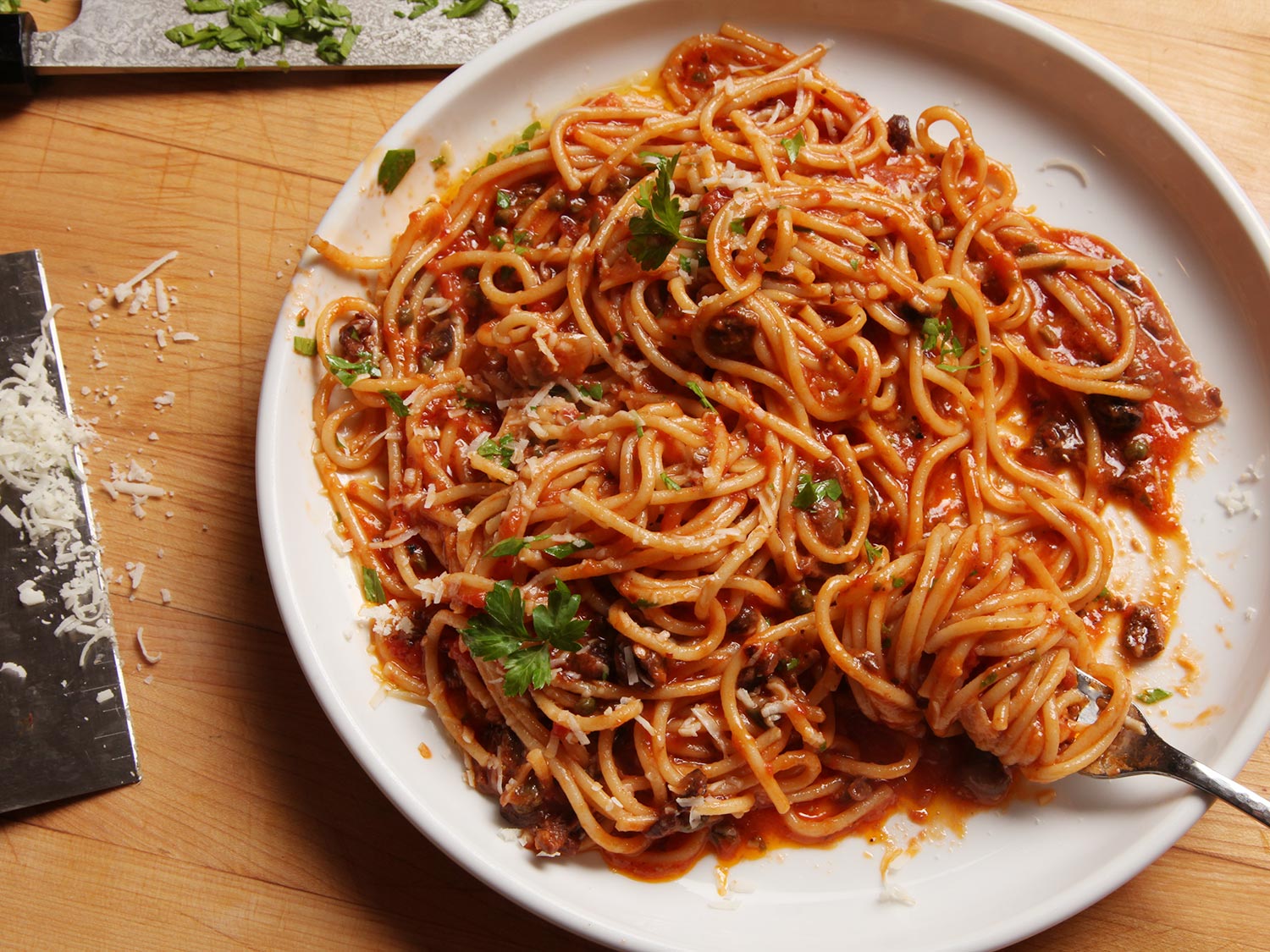
c/o seriouseats.com
Puttanesca is easy to make, and all of its ingredients can be found at Weshop. It’s a fantastic dish for when you want to put neither time nor effort into your cooking but still want a filling and delicious result. Puttanesca is packed with flavorful and aromatic ingredients, so for those of you worried about your culinary creations ending up tasteless, this dish will not disappoint. What’s great about this dish is that the recipe is only a starting point: After making puttanesca a few times, you’ll start thinking of all kinds of other flavors and textures you can add to make the dish even better. The creative and experimental element of cooking is one of my favorite things about it, and so I not only sanction your experimentation with this puttanesca recipe, I encourage it!
After doing some quick research on the dish, I was surprised to find that puttanesca is a fairly recent addition to the pasta sauce family, having apparently made its first appearance only in the 1960s. Growing up, this was a dish that both my mother and father frequently made for my brother and me when they got home from work. (Again, it’s quick and easy.) The fantastic smell of cooking garlic is ubiquitous in Italian-American households when approaching dinner-time. But unlike some other pasta dishes, the puttanesca’s aromatic ingredients like capers, Kalamata olives, parsley, and anchovies always let us know that puttanesca was being made. The scent gave it away every time.
Ingredients:
- Extra-Virgin Olive Oil
- 3-4 Garlic Cloves
- 1 Pack of Cherry Tomatoes
- Kalamata Olives
- Capers
- Fresh Parsley
- 2 Anchovy Fillets
- Half-Pound of Spaghetti
Instructions:
At your workstation, make sure you have enough space to prepare the ingredients and keep them separate from each other until it’s their time to go in the sauce. When cooking, always begin by preparing your ingredients. Start by peeling and finely chopping your garlic cloves. Wash all of your cherry tomatoes, then cut them in half along their length. Wash all your parsley, cut off the stems so only the leaves are left, and then chop the leaves a bit, not too finely. Use a fork or small spoon to take a few spoonfuls/forkfuls of capers and Kalamata olives, 3/4 cup’s worth, then chop them together finely. This way, you’ll have made an olive/caper paste that’s to die for. Finally, open your can of anchovies, take out two, and chop them into a paste.
Now you’re ready to cook! Heat a medium-sized frying pan on medium heat with a good splash of olive oil, then add your garlic. You’re trying to sauté the garlic, so you’re looking for it to be aromatic and sizzling, but beware: When garlic is over-cooked it becomes quite bitter. This is why I’d recommend aiming for slightly undercooked garlic that will then cook the rest of the way during the cooking process. Once the garlic is sautéed, place your cherry tomato halves skin-side up in the pan. At this point, cover the pan with a lid, turn the heat down a little, and wait a few minutes. You’ll know the tomatoes are done when you remove the lid, take a spatula, and lightly press on the top of your tomatoes. If they’re mushy and drip out their juices immediately then they’re ready. If they’re still a little firm, they need more time. When the tomatoes are ready, push them down lightly with your spatula to get as much of their juices out without pureeing them. Then, add your olive-caper paste as well as your anchovy paste. Mix in the olive-caper paste and anchovies into the sauce and allow the sauce to simmer for about two minutes. The danger here is letting it simmer too long and losing all that tomato juice, so be watchful!
At this point, you should begin boiling some water for the pasta. In these last few moments with your puttanesca, add your parsley and mix it in, turn the heat to low, and cover the pan. When the water boils, add whatever pasta you want—spaghetti is the classic, but not sole option—and cook it until it’s as al dente as you like it. One little tip: After straining the pasta, pour it into the frying pan and mix the pasta and sauce together in the frying pan itself. I know this will be cumbersome, but trust me, there is no better way of getting a good layer of sauce onto every piece of pasta than by mixing it in the pan. Add salt and pepper to your liking, place your creation in a plate or bowl, and then dig in.
As I said, get creative! Experiment! This recipe is not exhaustive of all possibilities; I personally love to ditch the anchovies and instead add chopped sun-dried tomatoes and melt-in-your-mouth shallots to my Puttanesca. This dish is quite close to my heart. It’s provided me with countless great and satisfying dinners, and I hope you’ll try this recipe out and taste it for yourselves! Buon Appetito!
Théo Storella can be reached at tstorella@wesleyan.edu.